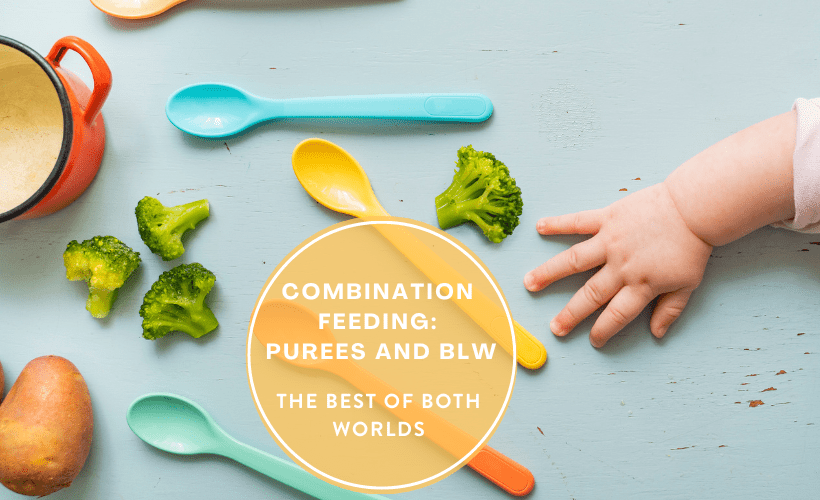
I recently wrote about the pros and cons of both BLW and puree feeding methods for Newbornbaby.com.au. While both approaches have their benefits, they also have potential drawbacks, especially when babies are having difficulties with feeding. A third method, combination feeding, offers the best of both worlds by incorporating elements of both BLW and purees. In this blog post, we will explore why combination feeding can be a good option for many families.
Age of baby
In Australia, some paediatricians and Maternal Child Health Nurses (MCHNs) suggest introducing purees as early as 4 or 5 months if a baby has reflux or if there is a family history of food allergies. It makes a lot of sense to use purees then, because these babies are not only unable to process thicker, lumpier textures, they are not ready to self-feed. Parents who are concerned should talk to their doctor or MCHN.
For the majority of babies, the World Health Organisation’s (WHO) recommendation can be safely followed to start solids at six months plus signs of readiness. It fits the BLW approach well, which postulates that at 6 months babies are developmentally advanced enough to handle some self-feeding with solid foods with more texture and complexity. These foods do however have to pass the squishy test, in other words they should “dissolve” between your thum and index finger.
One of the main benefits of BLW is that it can help babies develop their fine motor skills, hand-eye coordination, and self-regulation. BLW also encourages babies to listen to their own hunger and fullness cues, rather than being pushed to eat a certain amount or type of food.
Combination feeding
Combination feeding, as the name suggests, involves a mix of spoon-feeding and finger foods. Caregivers can offer purees or mashed foods, and finger foods in the same meals. Combination feeding offers the best of both worlds, allowing babies to experience different textures and flavours while also providing opportunities to learn important oral motor skills.
This, from my perspective of extreme fussy issues, is beneficial.
-
Some babies need to eat sufficient amounts with purees, so they can relax and start exploring finger food. You can offer puree via a spoon first. Take cues, and ensure the spoon is placed where baby can see it, so he tilts forward in agreement to cup the spoon between his lips and then pulls the content in his mouth. The baby will then do some vertical jaw movement as the puree forms into a bolus, ready to be swallowed. This is already one skill that baby is learning. Then you can offer a second course of finger foods baby is now happy to explore. Fingers food should be squishy as baby need to gradually learn eating skills. Jumping too far ahead , too quickly may result in excessive gagging, which while a protective mechanism, may create a negative association with eating if too intense.

-
Purees can be easily enriched with iron or calories. Iron-rich sources include meat, poultry or liver, fish, lentils, tofu or dry iron-fortified cereals. For calories add olive oil, butter, or formula to the puree.
-
Purees with lumps are tricky for many children. They require baby to isolate the lumps from the puree, then push lumps to the side of her mouth to mash them between her gums or molars. This is an important skill for babies and toddlers. Opportunities to practice are necessary and complementary to offering finger food. In this case, purees will become casseroles, or risotto as the child grows. Parents will be able to detect texture sensitivity, or oral-motor difficulties to progress textures. Any difficulty with progressing textures and managing lumps can then be discussed with a GP and perhaps addressed by a Speech Language Pathologist. The opportunity at that stage for babies to get messy with sticky puree on their hands is important with the view to help increase babies levels of comfort.

Before BLW became touted as the best method to introduce solids, parents who raised their kids did a combination of purees and self-feeding. It made a lot of sense to offer finger food as soon as children showed signs of readiness. Around 12 months of age we moved to table foods that were often extracted from our main meal and cut to manageable size or texture. Perhaps we used purees for longer than necessary, but I am not even sure anymore. I just know the progression was very natural for our children.
Combination feeding offers a practical and pretty natural progression, without the pressure of doing it right! It can be adapted to meet the baby’s needs and progress. It gives babies an opportunity to acquire a wider variety of skills, especially managing complex, lumpy textures. If you are struggling with your baby feeding, then talk to someone about it.


